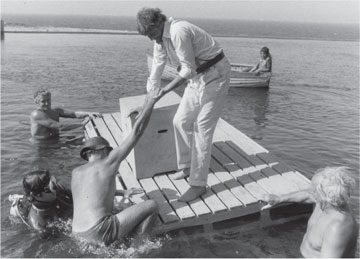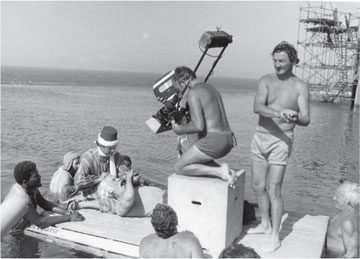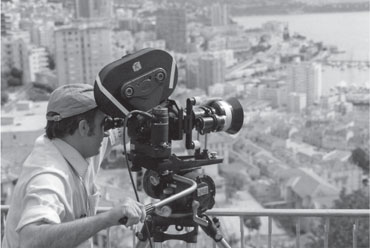Read Shooting 007: And Other Celluloid Adventures Online
Authors: Sir Roger Moore Alec Mills
Shooting 007: And Other Celluloid Adventures (23 page)

What do you mean, ‘RUN!’?

A kindly helping hand from Roger Moore, which would have been even more appreciated if he hadn’t been the one who pushed me into the water in the first place!

Filming Lee Marvin’s close-up for the life raft sequences in the large tank at the Mediterranean Film Studios on Malta. This is the only European filming tank that has a south-facing natural horizon with the real sea, giving the camera operator a far greater degree of movement.
Mindful that some directors automatically ignore alternative suggestions put to them from those in their close team, I might have hesitated in offering a suggestion. My normal hesitation came with the thought that some directors allow their egos to get in the way of the problem, but this was never the case with Peter Hunt, who had previously taken me to one side when I was reluctant to speak up about any thoughts I had, worried that they would intrude on the director’s territory.
‘Alec, if you have an idea to make a scene interesting, tell me. If I like it I may use it!’
Of course, I understand this can be thorny territory to tread on with some directors, but in my experience difficult directors have been in the minority. I am not suggesting that directing by committee is desirable – absolutely not. Even so, the camera operator, remembering Ernie Day’s professional relationship with Ken Annakin, is very much a part of the director’s team.
In the dreadful silence and with no sign of any other ideas I reluctantly –
very
reluctantly – offered a suggestion to Peter. With Roger’s immaculate costume partly consisting of highly polished brown shoes, contrasting with Lee’s grubby clothes with dirty worn-out boots turned up at the toes – a scruffy bugger – I could follow Roger’s shoes with the camera as he paced up and down, timed to the off-screen dialogue, eventually taking the camera over to Lee’s unsightly boots where, if necessary, the rest of the scene could be filmed on the actors’ faces when Lee sobered up. It was not much to offer but Peter agreed this was all we could hope for in Lee’s present condition.
‘ACTION!’
More in hope than expectation, Roger’s polished shoes walked to and fro with the camera staying with his every move as the scene covered the required dialogue. With the eventual arrival of Lee’s footwear into shot, through the camera it suddenly seemed as if Lee’s boots were starting to tip backwards, heading out of frame. He had passed out!
‘CUT!’
Lee Marvin was a likeable man who had little control over his alcohol intake, which at times could be embarrassing for all to witness. One scene on board the fictional German battleship
Blücher
would leave all the cast waiting around while Lee could barely stand, yet somehow that did not matter as we all loved him. You took Lee as you found him.
Lewis Gilbert is a true professional in every sense of the word, a director with whom I had the pleasure to work on four films, a man who contributed much to a relaxed atmosphere on the set, so when he asked if I would join him on a trip to Japan my ‘Yes please’ came long before the director had finished extending his kind invitation.
Seven Nights in Japan
was a story of love in unusual circumstances, with an attempted assassination of a British prince played by Michael York, because of his love for Japanese girl Hidemi Aoki.
Japan would be a new experience for me. I had heard rumours suggesting that Japanese people ate raw fish with rice at every opportunity – a bizarre combination should this be true. To be honest, I have absolutely no idea where this silly idea came from, unless it was a strange person who will remain nameless winding me up. Even so the thought of it would quickly cool my earlier enthusiasm for the trip. What would also be unhelpful was the idea associate producer Bill Cartlidge had in mind for the catering, introducing the crew to a Japanese supermarket which, as you would expect did not go down well; with all this nonsense I settled for the occasional Kobe steak, which would probably have made a minuscule dent in Bill’s monetary plans.
Once again Henri Decae was the director’s chosen cinematographer, although I later suspected that Lewis was less enthusiastic about that decision. Little things were starting to bother him and were clearly noticeable as Lewis sat near the camera – my domain – where I take note of all that goes on.
Hearing of my forthcoming Japanese trip the headmaster of Simon’s school had asked a favour of me: if possible, could I contact a university lecturer, an old colleague of his now living in Tokyo, just to say ‘Hello’? When we eventually arrived in the capital city towards the end of our Japanese location I duly contacted the university, passing on the headmaster’s message and being more than grateful that the don’s English was good enough to understand me and say that he would be in touch with Simon’s headmaster about our meeting. With this in mind I thought it appropriate to invite the professor with his wife to join me for dinner at our very smart hotel, believing that this would impress him, and he accepted.
So that we could recognise each other, we arranged to meet outside the hotel. A small gentleman stepped from a chauffeured limousine where I – 5 feet 5 inches tall in shoes – looked down on this kindly old gentleman. Evidently the academic was well-known and respected by all the locals, who eagerly gathered around him as he turned to me, smiling politely and bowing. Meanwhile his wife, a sweet old lady, emerged from the car in full kimono dress, also bowing her head and remained that way, standing a little behind him. What to do, methinks?

Seven Nights in Japan
(1975) and another photo for the album.
Unsure what to do next but at the same time certain that I did not want to offend these beautiful people with their traditions, in my unease I held out my hand, half bowing half nodding, Del-Boy style, hoping that he would at least appreciate the gesture. Regaining control, I then led the professor to the restaurant, with his wife insisting on keeping her distance behind; I slowed down, encouraging the dear lady to join us, but that didn’t work and she preferred to keep her distance from the two men. I was surprised that this tradition still existed in modern Japan, but again this could have been a custom the older generation preferred to observe. The evening passed slowly – very slowly – the conversation was difficult with embarrassing long pauses. In the end I doubt that I did Simon any favours at all, but this was a new country to visit and a new experience to see the diverse locations in Kyoto and Tokyo.
With filming soon to end, Lewis quietly called me to one side from the unit, waving a cable from Cubby Broccoli inviting him to direct the next James Bond film. I was delighted for Lewis as it had been almost ten years since he had directed
You Only Live Twice
, and was even more delighted when he asked if I would join him on
The Spy Who Loved Me
, confirming that our professional relationship was strong and would continue on his next two films.
With my puffed-up ego working overtime I decided that operating the camera was probably the most rewarding position in the camera department, where, detached from all the politics around me, I could at least ‘hide’ under my black cloth, a place where at times it would seem as if the actors were performing just for me. No doubt this assertion would appear strange if not ridiculous to some, so let me underline this by telling of an Ernie Day operating experience when he was on
Lawrence of Arabia.
The scene Ernie described was a Peter O’Toole monologue, with the camera focused entirely on the actor. To assist the performance, David Lean required the camera to track slowly forward into a close up, the timing of the movement synchronised to the actor’s performance – a simple shot on the face of it. After one rehearsal for timing, Ernie and grip were both ready.
‘ACTION!’
The camera moved slowly forward as rehearsed, the tracking precisely timed before coming to a stop as rehearsed at the end of O’Toole’s long dialogue. The actor then slowly stood up, again as rehearsed, but the camera did not follow him as planned. Ernie Day, my hero and probably the best camera operator of all time, admitted that he had been ‘hypnotised’ by O’Toole’s performance, which was obviously a compliment to the actor’s technique even if not apparently appreciated by Mr O’Toole, who would leave Ernie with unprintable thoughts on this matter.
You may remember that Ken Annakin had asked Harry Waxman to use Ernie Day as his operator on
Swiss
Family
Robinson
– the director’s confidence in his camera operator was important to him. However, it would seem that even Ernie had his failings, so at least I could console myself when remembering how I let down Harry Waxman. Like Ernie, I am a human being after all.
Four long months would pass before my planned assignment with 007 was due to begin, a brief meeting with Eon’s production office suggested that I should make myself available from mid-August onwards. With my constant travelling around the world, staying at home would make a welcome change, particularly with the tidying up of family issues. Cherry Trees with its resident ghost was now sold and past history so a temporary move back to Croxley Road would be necessary while I hunted for a new family home – perhaps in London?



